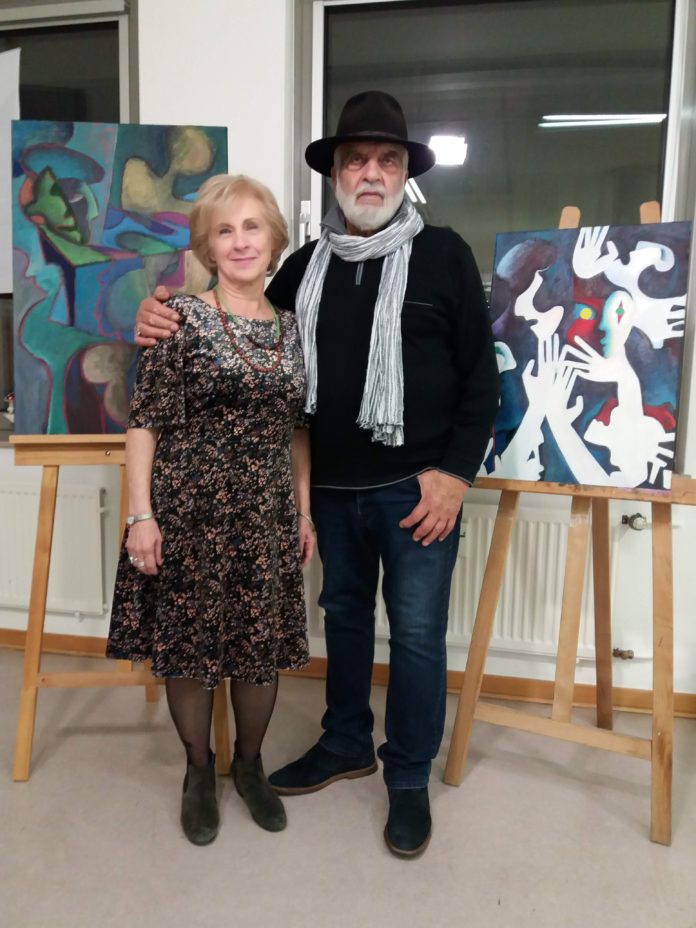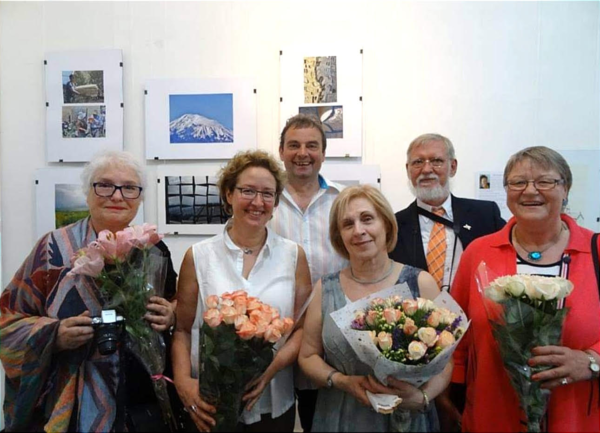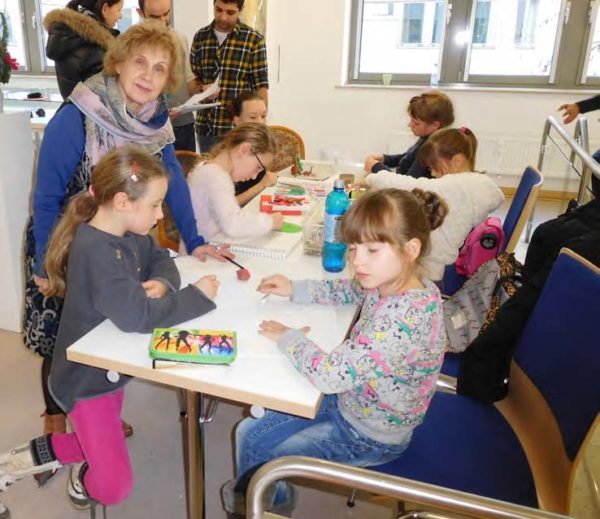
Nona Gabrielyan and Van Soghomonyan
Armenian Artists Return Home
by Muriel Mirak-Weissbach
WIESBADEN, February 24, 2022 — After 30 years’ living and working in Germany, two leading Armenian artists are packing up their canvases and brushes, their books and personal belongings, and will soon board a plane for Yerevan. Nona Gabrielyan and her husband, Van Soghomonyan, are an institution in Wiesbaden, the capital of the federal state of Hessen, located in the Rhine-Main area near Frankfurt. Since 1992, when they arrived here from Yerevan, their Atelier N&V has been a reference point for artists, students and art lovers. It is located on the Bismarckring, one of the main arteries of the city, this one named after the famous Iron Chancellor, who oversaw the unification of Germany.
On November 27 and 28, the atelier filled up with people, friends and collectors, who had received an invitation to come by, to say farewell. “It is difficult for us to leave Germany,” they had written, and expressed their joy at being able “to greet so many friends at this time.” They will be sorely missed.
In their workshop and gallery, they have not only painted and sculpted but, since 1995, have shared their craft and works with the community. In that year, Nona Gabrielyan began teaching master classes in painting and graphics, and has educated more than 55 aspiring artists. In addition, beginning in 2004, she began lecturing on Culture and Creativity at the local Volkshochschule, an institution for adult education, and continued for 16 years.

Nona Gabrielyan (front row, 3rd from left) and her students at Yerevan exhibition, 2016
Art and Universality
Gabrielyan and Soghomonyan are Armenians, but their activity and art transcend national borders. Both were born in Tbilisi, Georgia, Soghomonyan in 1937 and Gabrielyan in 1944. Van studied at the Academy of Art there from 1956 to 1958, then at the Fine Arts and Drama Institute Yerevan from 1963 to 1969. Gabrielyan moved to Yerevan in 1963, where she studied sculpture at the same academy, graduating in 1968. The two met there and married in 1965. It was a time when ceramic art was undergoing innovative changes, and Gabrielyan explored the new possibilities in the medium to expand its expressive capacities in graphics and painting, especially using clay. In 1971 she and her husband became members of Artists’ Union of Armenia. In the 1970s and 1980s, Soghomonyan was working in sculptural ceramics, which one critic categorized as “lyrical and philosophical.”
In the 1990s Armenia was going through multiple crises with the earthquake, the collapse of the Soviet Union and the Karabakh war, which plunged the population into chaos, hunger, poverty.
The two artists had received an invitation to travel to Wiesbaden and present their works at an exhibition, but precisely because of the political and security crises at the time, it took a while before they could arrange for visas. In 1992 they finally received their documents, and set out with their daughter, son-in-law and their young grandson. The younger family stayed for a year, then returned to Yerevan, whereas Van and Nona remained, and made Germany their home.
It could not have worked out so well, Gabrielyan told me, if they had not received the substantial support of the artistic community and the city of Wiesbaden. It was Ruth Zais, a leading patron of the arts and descended from the family of the architect associated with many historic buildings there, who extended the invitation for an exhibition at the Haus der Heimat (Homeland House), and the authorities issued visas allowing them to come to Germany, and to work as artists. Zais was enthusiastic about the couple’s art and purchased several works.
“We paid our way with our works,” Gabrielyan said, and, indeed, they succeeded in selling sculptures and paintings which are now housed in numerous private collections in German and other European cities. Both artists express their continuing gratitude for the backing they have received over the years, and the enduring friendships that they have formed with collectors and customers.
They were already established artists when they arrived, having taken part in exhibitions not only in the Soviet Union but also in Western European cities. Van Soghomonyan began presenting his works in group exhibitions in 1971 and solo shows in 1980. In Faenza, Italy, where they both exhibited several times, Soghomonyan won the first award in the International Competition of Contemporary Ceramic Art in 1983. They had also been present in Germany. In 1984 they displayed works at a show in the West German city of Westerwald (noted for its glazed pottery) entitled, “Contemporary Ceramics from the Soviet Union.” Since 1980, Nona Gabrielyan has held solo exhibitions in Yerevan, Moscow and Paris, as well as numerous cities in Germany. She participated in the International Symposium of Ceramics, House of Creativity of Artists Dzintari, Latvia in 1974, 1976 and 1983 and presented her works in group exhibitions in Prague, Warsaw, Budapest, Leningrad, Moscow, Faenza, Vallauris (France), Montreal, and of course Yerevan and numerous German cities including Berlin.
Cultural Dialogue
The Haus der Heimat, which hosted their first Wiesbaden appearance in 1992, is an important venue for cultural dialogue and exchange. It is known as a “home away from home” for former refugees and their organizations from Eastern Europe. Numerous Germans whose ancestors migrated to Russia centuries ago have returned to their native land, and the Haus der Heimat is a meeting place for them. Vera Maier, who returned in 1988, is leading the integration program, known as “Together Wiesbaden,” which has sponsored activities aimed at facilitating mutual understanding. Art and art exhibitions have played a central role in this process. As Gabrielyan has often stressed, nations have borders but culture has its unique qualities: “Art is a universal language, especially painting and music! Everyone can understand it, without translation.”
Their first event in 1992 was a success, and it paved the way for further activities. In August 1993 they presented works again in Wiesbaden, this time at the majestic Kurhaus, a historic architectural complex functioning as a center for cultural events. They would return to the Kurhaus again and again for further shows in the first decade of the new millennium, and present their artworks in the famous Christian Zais Hall. In 1993 a large number of their creations, especially sculptures in bronze and other materials, were on display, some outdoors on the spacious Bowling Green, which is flanked by colonnades and plane trees, and others in the vast exhibition hall. Gabrielyan presented sculptures, including a massive female torso entitled “Victim,” as well as painted ceramics, some of which critics compared to profiles by Marc Chagall. A dialogue between the two unfolded in that show, around themes related to their personal and national past experiences. On the green outside stood the monumental structure by Soghomonyan entitled “20th Century,” bearing the scars of catastrophe, inside, his “Meditation,” a human figure with head on stomach; abstract geometrical forms depicting “Time and Space,” and “Forest,” four damaged cylinders enclosed by a metal ring. (See https://www.youtube.com/watch?v=PGypxfrKlHY)

Nona Gabrielyan and her students
Soghomonyan has described his works in personal terms. “I have seen so much brutality, especially against Armenia,” he said, “that it is necessarily reflected in my work. Many works can be seen as requiems, as outcries….” His art deals “with the 20th century, the experiences of my generation and my people. Even what one has not personally experienced is transmitted genetically.”
Tragic elements in Armenian history have impacted his wife’s works as well. “There is the helplessness of the soul,” she has said, “in the face of catastrophe, whereby I have in mind not so much the earthquake as man’s capacity for aggression. But I believe he has an even greater capacity to protect himself from aggression, and the most effective method to achieve that is not to resist. It is a spiritual attempt to overcome aggression.”
Both artists counter the threats posed by nature and man with their religiously shaped hope for reason and tolerance, wrote Dr. Renate Luckner-Bien from the Art College Burg Giebichenstein.
Integration a Two-Way Street
Living and working in a new, foreign country is not easy for anyone; one has to learn the language, become acquainted with the political environment, adapt to the customs and culture. For Gabrielyan, art was the medium through which she could engage in this cultural exchange process. Working with her husband in their Wiesbaden atelier on their own creations, she began to offer art education in the form of classes in their studio and delivered lectures in a local institution for adult education. At the same time, she began writing, and over the years has published many literary works, including poetry and short stories with illustrations, both in Russian and Armenian, some of which have appeared in German as well.
It was a two-way street. While she imparted her knowledge of and love for art to her students, she was learning the German language, and through it, the culture. Her teaching relationship to her students developed into friendship, cultural exchange and collaboration. Just as they were introducing her to Germany, she sought to acquaint them with other cultures. She organized artistic working trips with her students to various foreign lands, spending weeks in Tuscany, France and Armenia itself.
Many of her students visited Armenia this way for the first time. “No one gave me this task,” she said. “I just wanted to let them know where I came from.” Twice, in 2014 and 2016, when she had solo exhibitions at the Museum of Modern Art in Yerevan, she arranged for her students’ works to be displayed alongside her own. Now, she told me recently, many of her students travel regularly to Armenia independently.
In late 2018, she hosted a show at the Haus der Heimat, entitled “Exhibition 1 + 9,” which included the works of nine of her students as well as her own. This was the third time she was sharing the stage with her students. And, since many of them had participated in painting excursions abroad, she arranged for photo montages of those field trips to be on view.
In remarks to visitors, she said, “All the young women whose works are exhibited here are not only my students but also my friends, for me and my whole family. Formerly I knew Germany through its literature and art history. Now I love Germany through my students and friends. And they, through me, have been able to know and love my country Armenia. Some of them visited, with their husbands.”
Gabrielyan has facilitated exchange programs for artists of the younger generation. In winter 2016, she had collaborated on a showing, again at the Haus der Heimat, of works by six young Armenian artists. Entitled, “Melody of Color,” it presented paintings and sculptures of remarkable mastery and originality.
In addition to the fruits of their endeavors, the six young men offered instruction, on an informal basis, to very young children, who would come in on weekends. Some of them were no older than 4 or 5, all eager to take crayon and pencil in hand and imitate the visiting artists. Most of them were third generation Germans, whose forefathers had migrated to Russia long ago, and whose parents had now returned to Germany. The Haus der Heimat offered them the opportunity to introduce their children to their new home, through classes in the language as well as dance and art.
Art as a Family Tradition
One of those six young artists visiting from Armenia was Guy Ghazanchyan, the grandson of Nona and Van, who had first come to Wiesbaden as a tot. Like his mother, Lilit Soghomonyan, and father Gagik Ghazanchyan, Guy grew up in an artists’ family. He earliest memories take him back to the atelier in Wiesbaden, where his parents and grandparents painted and sculpted. He said he grew up thinking that “everyone was an artist.”
The family exhibited together in Germany at the very beginning, and in May 1995 held a show in Kreishaus, in Bergheim. As local press accounts reported, there were mythological subjects and figurative subjects, rendered in painting as well as plastic arts. If Armenian motifs were at times cast in relation to the Soviet traditions they had studied, at the same time, the national character emerged clearly in themes drawn from Armenian history and religion.
Now, when Gabrielyan and Soghomonyan return to Yerevan, they will reunite with their family, which includes two grandchildren and a great-grandchild. All of them, needless to say, have entered the art world, albeit at varying stages of development…. Guy has recently attracted broad attention with an exhibition at the Yerevan Modern Art Museum entitled, “Witness.” (See https://mirrorspectator.com/2021/12/16/pictures-at-exhibition-raise-profound-issues/)
Armenia has gone through profound changes since they lived there decades ago, but theirs is a family and a nation of artists. As Van was once quoted saying, “My home is everywhere that I can live and work.” And Nona was of the same view: “An artist belongs to the whole world and the whole world belongs to the artist.”